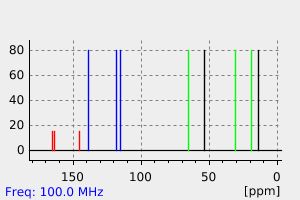n-Butyl 6-methoxypyridine-2-carboxylate | 75-32-1
中文名称
——
中文别名
——
英文名称
n-Butyl 6-methoxypyridine-2-carboxylate
英文别名
butyl 6-methoxypicolinate;Butyl 6-methoxypyridine-2-carboxylate
CAS
75-32-1
化学式
C11H15NO3
mdl
——
分子量
209.245
InChiKey
DBDUFPZRSAVLOF-UHFFFAOYSA-N
BEILSTEIN
——
EINECS
——
-
物化性质
-
计算性质
-
ADMET
-
安全信息
-
SDS
-
制备方法与用途
-
上下游信息
-
文献信息
-
表征谱图
-
同类化合物
-
相关功能分类
-
相关结构分类
计算性质
-
辛醇/水分配系数(LogP):2.6
-
重原子数:15
-
可旋转键数:6
-
环数:1.0
-
sp3杂化的碳原子比例:0.45
-
拓扑面积:48.4
-
氢给体数:0
-
氢受体数:4
反应信息
-
作为产物:描述:2-溴-6-甲氧基吡啶 、 carboxy MIDA boronate 、 正丁醇 在 [(di(1-adamantyl)butylphosphine)-2-(2′-amino-1,1′-biphenyl)]palladium(II) methanesulfonate 、 三乙胺 作用下, 反应 18.0h, 以80%的产率得到n-Butyl 6-methoxypyridine-2-carboxylate参考文献:名称:碳硼酸盐在钯催化的羰基化转化中作为多功能的原位CO替代物摘要:羧基-MIDA-硼酸酯的应用(MIDA = N-甲基亚氨基二乙酸)作为各种钯催化转化的原位CO替代物进行了描述。先前曾证明,羧基MIDA硼酸酯是合成硼酸化杂环化合物的长凳稳定的含硼结构单元。本研究表明,羧基-MIDA-硼酸酯除了可用作杂环合成的前体外,它还是一种出色的原位CO替代物,可耐受胺,醇和碳基亲核试剂等反应性功能。在钯催化的氨基羰基化,烷氧基羰基化,羰基化的Sonogashira偶联和芳基卤化物的羰基化的Suzuki-Miyaura偶联中,突出了其广泛的官能团相容性。各种酰胺,酯,(杂)芳族炔酮DOI:10.1002/anie.202010211
文献信息
-
Efficient Palladium-Catalyzed Alkoxycarbonylation of <b><i>N</i></b>-Heteroaryl Chlorides - A Practical Synthesis of Building Blocks for Pharmaceuticals and Herbicides作者:Matthias Beller、Wolfgang Mägerlein、Adriano Indolese、Christine FischerDOI:10.1055/s-2001-14576日期:——The alkoxycarbonylation of various N-heteroaryl chlorides was examined in detail. Studies of the butoxycarbonylation of 2- and 3-chloropyridine revealed the importance of selecting both the right phosphine ligand and ligand concentration in order to obtain efficient conversion and selectivity. Amongst the different ligands tested, 1,4-bis(diphenylphosphino)butane (dppb) and 1,1′-bis(diphenylphosphino)ferrocene (dppf) led to the most efficient palladium catalyst systems for the conversion of 2- and 4-chloropyridines and similar heteroaryl chlorides. The best catalytic systems for the alkoxycarbonylation of less activated substrates, such as 3-chloropyridines, were found to be those containing 1,4-bis(dicyclohexylphosphino)butane. Good to excellent yields of a number of N-heterocyclic carboxylic acid esters were realized by applying the appropriate ligand in the right concentration at low catalyst loadings (0.005-0.5 mol% Pd). For the first time catalyst turnover numbers (TON) of up to 13,000 were obtained for the carbonylation of a (hetero)aryl chloride.详细研究了各种N-杂芳基氯化物的烷氧羰基化反应。对2-和3-氯吡啶的丁氧羰基化研究发现,为了获得高效的转化率和选择性,选择合适的膦配体及其浓度至关重要。在测试的不同配体中,1,4-双(二苯基膦)丁烷(dppb)和1,1'-双(二苯基膦)二茂铁(dppf)为2-和4-氯吡啶及类似杂芳基氯化物提供了最高效的钯催化体系。对于活性较低的底物,如3-氯吡啶,最佳催化体系是含有1,4-双(二环己基膦)丁烷的体系。通过在低催化负载量(0.005-0.5摩尔% 钯)下使用适当浓度的合适配体,实现了多种N-杂环羧酸酯的良好至优异产率。对于(杂)芳基氯化物的羰基化反应,首次获得了高达13,000的催化剂周转数(TON)。
-
Beller, Matthias; Indolese, Adriano F., Chimia, 2001, vol. 55, # 9, p. 684 - 687作者:Beller, Matthias、Indolese, Adriano F.DOI:——日期:——
表征谱图
-
氢谱1HNMR
-
质谱MS
-
碳谱13CNMR
-
红外IR
-
拉曼Raman
-
峰位数据
-
峰位匹配
-
表征信息
同类化合物
(S)-氨氯地平-d4
(R,S)-可替宁N-氧化物-甲基-d3
(R)-(+)-2,2'',6,6''-四甲氧基-4,4''-双(二苯基膦基)-3,3''-联吡啶(1,5-环辛二烯)铑(I)四氟硼酸盐
(R)-N'-亚硝基尼古丁
(R)-DRF053二盐酸盐
(5E)-5-[(2,5-二甲基-1-吡啶-3-基-吡咯-3-基)亚甲基]-2-亚磺酰基-1,3-噻唑烷-4-酮
(5-溴-3-吡啶基)[4-(1-吡咯烷基)-1-哌啶基]甲酮
(5-氨基-6-氰基-7-甲基[1,2]噻唑并[4,5-b]吡啶-3-甲酰胺)
(2S,2'S)-(-)-[N,N'-双(2-吡啶基甲基]-2,2'-联吡咯烷双(乙腈)铁(II)六氟锑酸盐
(2S)-2-[[[9-丙-2-基-6-[(4-吡啶-2-基苯基)甲基氨基]嘌呤-2-基]氨基]丁-1-醇
(2R,2''R)-(+)-[N,N''-双(2-吡啶基甲基)]-2,2''-联吡咯烷四盐酸盐
(1'R,2'S)-尼古丁1,1'-Di-N-氧化物
黄色素-37
麦斯明-D4
麦司明
麝香吡啶
鲁非罗尼
鲁卡他胺
高氯酸N-甲基甲基吡啶正离子
高氯酸,吡啶
高奎宁酸
马来酸溴苯那敏
马来酸氯苯那敏-D6
马来酸左氨氯地平
顺式-双(异硫氰基)(2,2'-联吡啶基-4,4'-二羧基)(4,4'-二-壬基-2'-联吡啶基)钌(II)
顺式-二氯二(4-氯吡啶)铂
顺式-二(2,2'-联吡啶)二氯铬氯化物
顺式-1-(4-甲氧基苄基)-3-羟基-5-(3-吡啶)-2-吡咯烷酮
顺-双(2,2-二吡啶)二氯化钌(II) 水合物
顺-双(2,2'-二吡啶基)二氯化钌(II)二水合物
顺-二氯二(吡啶)铂(II)
顺-二(2,2'-联吡啶)二氯化钌(II)二水合物
韦德伊斯试剂
非那吡啶
非洛地平杂质C
非洛地平
非戈替尼
非布索坦杂质66
非尼拉朵
非尼拉敏
雷索替丁
阿雷地平
阿瑞洛莫
阿扎那韦中间体
阿培利司N-6
阿伐曲波帕杂质40
间硝苯地平
间-硝苯地平
镉,二碘四(4-甲基吡啶)-
锌,二溴二[4-吡啶羧硫代酸(2-吡啶基亚甲基)酰肼]-







